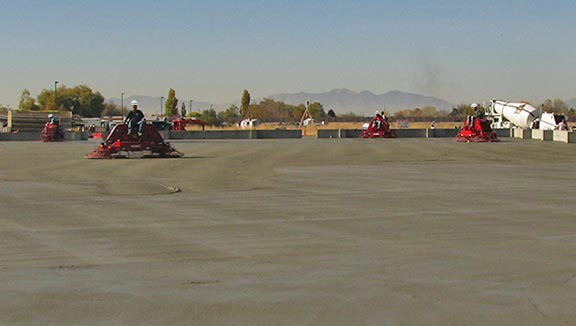Hidden Costs of Low-Quality Concrete: Why Cutting Corners Can Cost You Millions
The True Cost of Cheap Concrete
In the world of industrial and commercial construction, every decision impacts long-term performance, safety, and financial stability. Developers, contractors, and facility owners often face a difficult choice: cut costs upfront or invest in high-quality materials that stand the test of time.
While cheaper concrete solutions may seem appealing initially, the long-term consequences of using low-quality concrete can be devastating. From structural failures and costly repairs to safety risks and legal liabilities, poor-quality concrete can cost developers millions of dollars in unforeseen expenses.
At Messerly Concrete, we specialize in high-performance, durable, and long-lasting concrete solutions that eliminate the risks associated with inferior materials. This blog will explore the hidden costs of low-quality concrete and why investing in superior concrete technology pays off in the long run.
The 5 Biggest Risks of Low-Quality Concrete
1. Cracking, Curling & Structural Weaknesses
Concrete is expected to endure constant stress, heavy loads, and environmental exposure. When developers cut costs by using lower-grade cement, poor reinforcement techniques, or improper curing methods, the result is:
• Early-age cracking and shrinkage that weakens the structure.
• Concrete curling in industrial floors leading to unsafe working conditions.
• Compromised load-bearing capacity, causing long-term safety concerns.
The Cost: Repairs for large-scale industrial floors can cost $20-$50 per square foot, significantly higher than the initial investment in high-quality concrete.
2. Increased Maintenance & Repair Costs
Low-quality concrete requires frequent patching, resurfacing, and crack sealing. Over time, these ongoing costs far exceed the initial savings from using cheap materials.
Common maintenance expenses include:
• Surface grinding and joint stabilization for cracked floors
• Replacing broken concrete panels in tilt-up construction
• Resealing and recoating surfaces that fail prematurely
The Cost: A concrete floor with inferior materials may need resurfacing every 3-5 years, whereas a properly designed industrial floor can last 20+ years with minimal maintenance.
3. Safety & Liability Risks
Structural failures and deteriorating surfaces don’t just lead to expensive repairs—they create serious safety hazards.Industrial facilities, distribution centers, and manufacturing plants depend on precision-engineered concrete to ensure worker safety and operational efficiency.
Risks of low-quality concrete include:
• Tripping hazards & unstable flooring – A major risk in warehouses, logistics hubs, and factories.
• Forklift damage & equipment failures – Uneven surfaces cause shock-loading damage to expensive machinery.
• Foundation shifting & seismic vulnerability – Poorly reinforced structures are more likely to collapse during seismic events.
The Cost: Workplace injuries due to unsafe flooring can lead to lawsuits, regulatory fines, and lost productivity. A single personal injury lawsuit can cost a business over $100,000 in legal fees and settlements.
4. Poor Performance in Harsh Weather & Seismic Conditions
Developers in Utah, Idaho, and Nevada know that concrete must withstand extreme conditions—from scorching summer heat to freezing winter cycles and seismic activity.
Inferior concrete mixes fail faster in these harsh environments, leading to:
• Freeze-thaw cracking in colder climates (Utah, Idaho)
• Thermal expansion damage in desert heat (Nevada)
• Increased spalling, surface flaking, and erosion
• Structural damage during earthquakes due to poor reinforcement
The Cost: A full replacement of a cracked and deteriorating concrete slab can cost 3-5 times more than using high-quality concrete upfront.
5. Shorter Lifespan & Reduced Property Value
Low-quality concrete decreases the overall lifespan of a building or facility.
• Industrial floors with subpar materials may need replacement in just 5-10 years.
• High-performance concrete lasts 30+ years, reducing the need for costly renovations.
• Buyers and investors look for durability—poor-quality materials decrease resale value.
The Cost: A commercial facility built with low-grade concrete may lose 10-20% of its property value due to increased maintenance costs and shorter lifespan.
The Messerly Concrete Advantage: Why We Build It Right the First Time
At Messerly Concrete, we provide high-performance, long-lasting concrete solutions that eliminate the risks associated with low-quality materials.
1. Ultra-Flat Industrial Flooring for Maximum Durability
• FF/FL 60+ tolerance floors built for automation & heavy traffic
• Precision laser-guided finishing to eliminate surface imperfections
• Densified, wear-resistant concrete to prevent cracking & dusting
2. Seismic-Resistant Structural Concrete
• Post-tensioned slabs and deep foundations for earthquake resilience
• Reinforced concrete panels that exceed seismic safety standards
• Smart concrete technology with embedded monitoring sensors
3. Sustainable & High-Strength Concrete Mixes
• Carbon-reduced concrete that lasts longer while meeting environmental goals
• Optimized mix designs to minimize shrinkage and maximize strength
• Self-healing concrete solutions for minimal maintenance
4. Heavy-Duty Pavements & Transit Infrastructure
• Designed for extreme truck loads, warehousing, and intermodal facilities
• Joint-free, reinforced concrete slabs for high-impact environments
• Slip-resistant and freeze-thaw-resistant surfaces
5. Expert Engineering & Project Execution
• Decades of experience in commercial, industrial, and public infrastructure
• Proven track record in tilt-up construction, logistics centers, and municipal projects
• Custom concrete solutions tailored to the client’s exact needs
Conclusion: Invest in Quality, Save Millions in the Long Run
Cutting corners with cheap concrete may save a few dollars per cubic yard upfront, but the long-term costs in repairs, legal liabilities, and operational inefficiencies far outweigh the initial savings.
Developers and contractors working on high-value projects in Utah, Idaho, and Nevada need precision-engineered concrete solutions that stand the test of time.
At Messerly Concrete, we don’t just pour concrete—we engineer performance.
If you’re looking for a high-quality, long-lasting concrete solution for your next project, let’s talk.
Contact Messerly Concrete Today:
📞 (801) 731-3226
📧 business@messerlyconcrete.com
📍 Serving Utah, Idaho, Nevada & the Western U.S.
Messerly Concrete: Stronger. Smarter. Built to Last.





